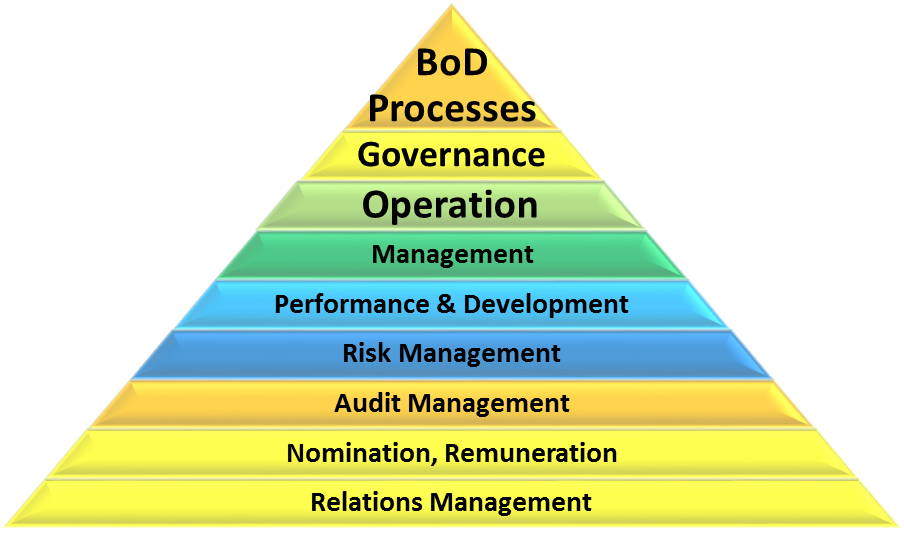 The Board must not only direct, supervise and represent the organization but must also set the example. It must have well-structured and defined processes. Each should have its deliverables, its requisite KPIs, its requisite competences - in terms of knowhow and experience, its requisite competencies –in terms of personal qualities and capability and willingness to implement them- and its objectives and measurement procedures. The Board processes, as a rule, should include at least the following ones:
The Board must not only direct, supervise and represent the organization but must also set the example. It must have well-structured and defined processes. Each should have its deliverables, its requisite KPIs, its requisite competences - in terms of knowhow and experience, its requisite competencies –in terms of personal qualities and capability and willingness to implement them- and its objectives and measurement procedures. The Board processes, as a rule, should include at least the following ones:
Board function has changed significantly during the last few decades. The scandals and fiascos of major companies in USA and in Europe resulted in the Sarbanes – Oxley code and in strengthening the Corporate Codes in most countries. However, there is still a lot to be done, not so much as an obligation for reporting but as one of the most important enablers for achieving and maintaining success and sustainability. A 21st century organization’s internal Corporate Governance Code should be its Code of Ethics and should transcend and pervade the whole organization and all its processes.
How the Board operates is of utmost importance for its effectiveness and efficiency. Of significance are, inter alia, how agendas are set up and discussed, how each member is not only allowed but also prompted to express his opinion, how critical questions are raised and answered and how discussions on critical and controversial issues are exhaustively researched, carried out and concluded, how particular issues are relegated to specific committees and their conclusions fed back to the Board for decision making.
Managing effectively and efficiently a Board is not an easy job –though, unfortunately, frequently understated. It is indeed difficult and requires not only knowhow and expertise but also diplomacy and leadership skills. Quite a few companies, both private and public, have vanished because of bad Board management. The duties of the Chairperson as the Board manager are not unlike those of any other line manager, though much more difficult since he/she must manage peers as equal among equals!
Assessing the performance of the board on a collective and on a personal level is considered nowadays an absolute must, though not adequate in the least. It must be followed by the formulation and execution of personal development plans.
Though cutting edge management theory and practice dictate that ‘risk management’ should be ‘embedded’ in all business core and support processes, it is of vital importance for securing business continuity and sustainability to have a formal process for ‘risk assessment and management’ at both the Board and the Management Committee levels.
Having a formal ‘internal audit’ process is not only obligatory for public companies but a necessary precaution against fraud and an enabler for capturing promptly mistakes and weaknesses. The Board Audit Committee should have a process for directing the corporate audit processes. It should ensure that (a) the corporate core and support processes have and implement effective internal audit systems and procedures, (b) the Internal Audit Dept, if existing, does function effectively, as a vital tool of both the Board and the Executive Management and (c) all IA suggestions are timely implemented. The Chairperson must ensure that the Board's own operation is audited and reported.
Achieving and sustaining high board performance requires an effective process of nominating, recruiting, developing, evaluating and rewarding both the Non-executive board members and the organization’s top executives.
The Board does not only govern the organization but simultaneously represents the owners (via the General Assembly) and all other stakeholders and reports to all stakeholder communities: owners, authorities, employees, partners, the community and the customers. In a modern organization it must strive to serve in a balanced way the interests of all stakeholders.


